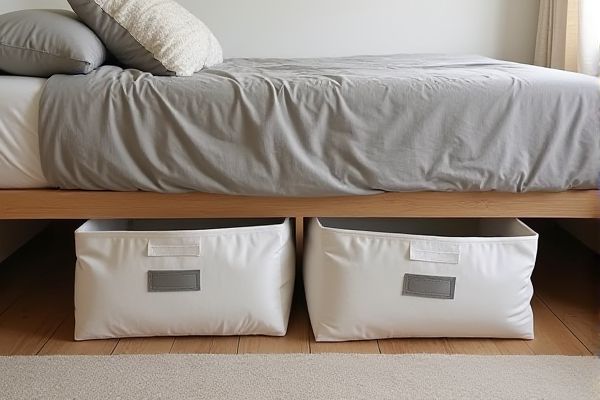
Under-bed storage bins offer sturdy, easily accessible organization solutions that protect your items from dust and damage, while vacuum storage bags save space by compressing soft goods like clothing and bedding but require careful handling to avoid punctures. Explore the rest of the article to determine which option best suits your storage needs and lifestyle.
Table of Comparison
| Feature | Under-bed Storage Bins | Vacuum Storage Bags |
|---|---|---|
| Storage Method | Rigid bins stored under the bed | Compression bags removing air for compact storage |
| Space Efficiency | Moderate; utilizes under-bed space without compressing items | High; dramatically reduces volume by compressing textiles |
| Material Protection | Protects from dust and pests with sealed lids | Protects against dust, moisture, and mold when sealed properly |
| Durability | Sturdy plastic or fabric construction; reusable long-term | Dependent on bag quality; prone to punctures; reusable but limited lifespan |
| Accessibility | Easy access without unpacking | Requires deflating and reopening to access items |
| Ideal Use | Bulky items like shoes, books, or bedding | Clothing, blankets, pillows needing volume reduction |
| Cost | Higher initial investment; reusable over time | Lower initial cost; may require replacement more often |
Introduction to Under-Bed Storage Bins and Vacuum Storage Bags
Under-bed storage bins offer a durable and easily accessible solution for organizing seasonal clothing and bulky items, making use of the often overlooked space beneath your bed. Vacuum storage bags compress soft textiles by removing air, significantly reducing the volume of your items for efficient storage in closets or under beds. Choosing between these options depends on your storage needs, available space, and the type of items you plan to store.
Space-Saving Efficiency: Comparing Storage Capacities
Under-bed storage bins offer rigid structure and easy access, making them ideal for organizing bulky items while maximizing under-bed space efficiently. Vacuum storage bags compress soft items like clothing and bedding, significantly increasing storage capacity by reducing volume up to 75%. Your choice depends on balancing accessibility with space-saving needs for optimal storage capacity.
Material Durability and Longevity
Under-bed storage bins are typically made from sturdy plastics or reinforced fabric, providing excellent durability and long-term protection against dust, moisture, and physical damage. Vacuum storage bags, constructed from multi-layered plastic materials with airtight seals, excel at compressing items to save space but may be prone to punctures or seal degradation over time. For prolonged use, bins offer superior longevity and resilience, while vacuum bags are better suited for temporary, compact storage needs.
Ease of Use and Accessibility
Under-bed storage bins offer quick and easy access to your belongings with rigid, stackable designs that slide smoothly under most beds, making organization straightforward. Vacuum storage bags require sealing and compressing, which can save significant space but may involve more effort and time, especially when accessing items frequently. You'll benefit from bins if convenience and frequent retrieval are priorities, while vacuum bags are better suited for long-term, space-saving storage.
Suitability for Different Items
Under-bed storage bins are ideal for bulky or fragile items such as shoes, books, and seasonal clothing, providing easy access and protection from dust and damage. Vacuum storage bags excel at compressing soft textiles like bedding, blankets, and off-season garments, saving significant space by reducing volume. Choosing between them depends on item size, fragility, and storage accessibility needs.
Protection Against Dust, Moisture, and Pests
Under-bed storage bins provide sturdy protection against dust, moisture, and pests due to their solid construction and airtight lids, making them ideal for long-term storage in humid or pest-prone environments. Vacuum storage bags compress items by removing air, reducing space but offering limited protection against punctures or sharp objects that can compromise their seal and allow moisture or pests inside. For environments with high moisture or pest risk, rigid under-bed bins ensure better preservation of stored belongings compared to vacuum-sealed bags.
Aesthetics and Home Organization
Under-bed storage bins offer a neat and structured appearance, enhancing home organization by keeping items visible and easily accessible while maintaining a tidy look. Vacuum storage bags maximize space efficiency by compressing bulky items, but their appearance may be less polished, often requiring careful placement to avoid clutter. Choosing the right option depends on your priority for aesthetics or maximizing storage capacity in your living space.
Cost Comparison and Budget Considerations
Under-bed storage bins typically cost more upfront but offer durable, reusable solutions without the risk of damaging your items, making them a long-term investment for your storage needs. Vacuum storage bags are usually cheaper initially and save space by compressing items, but may require replacement over time due to wear and tear and potential air leaks. Your budget should consider both the immediate cost and the longevity of each option to determine the most cost-effective choice for your storage requirements.
Pros and Cons of Under-Bed Storage Bins
Under-bed storage bins provide easy access and organization for seasonal clothes, shoes, and bulky items without compressing contents, making them ideal for delicate fabrics and fragile items. These bins are durable, reusable, and often transparent, allowing quick visibility of stored items, but they typically occupy more space compared to vacuum storage bags. However, their rigid structure may limit storage flexibility and can be harder to fit in smaller or tightly packed under-bed areas.
Pros and Cons of Vacuum Storage Bags
Vacuum storage bags save space by compressing bulky items such as blankets and seasonal clothing, making them ideal for maximizing your storage area. They protect contents from moisture, dust, and insects, but can be vulnerable to punctures which may cause air leaks and loss of compression. However, frequent use may cause wrinkles or damage to delicate fabrics, limiting their suitability for fragile garments.
 homyna.com
homyna.com